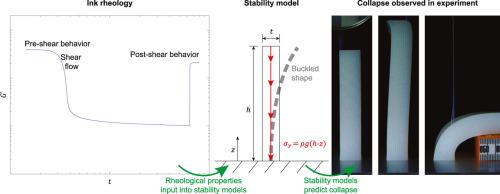Additive Manufacturing ( IF 10.3 ) Pub Date : 2020-10-03 , DOI: 10.1016/j.addma.2020.101621 Stian K. Romberg , Mohammad A. Islam , Christopher J. Hershey , Michael DeVinney , Chad E. Duty , Vlastimil Kunc , Brett G. Compton

|
Thermoset polymer composites show promise for additive manufacturing (AM) applications to address some of the limitations of the more widely used thermoplastic feedstock materials. Thermosets offer attractive mechanical properties while providing excellent interlayer bonding, high thermal and chemical stability, and reduced energy consumption as a result of deposition at room temperature. However, since thermoset resins rely on a crosslinking reaction to solidify, rather than quickly cooling like thermoplastics, viscoelastic properties must be relied upon to maintain deposited shape after deposition until crosslinking can occur. This fact has not impeded development and characterization of new thermoset feedstocks on the small scale, but recent efforts to increase scale of thermoset printing have highlighted issues with structural stability under self-weight. This study addresses issues of self-weight by investigating the mechanisms that cause collapse of tall, thin printed walls. Using nanoclay- and fumed silica-filled epoxy feedstocks, this work compares the collapse height for printed walls to stability models based on yielding and buckling mechanics. Inputs for these models – shear yield stress and storage modulus – were taken directly from parallel plate rheometry measurements. Model predictions were found to be in good agreement with experimental results, where both yielding and buckling behavior were observed, provided the rheological properties after a shear excursion were used as inputs. This work establishes a direct link between basic rheological properties of the feedstock, geometry of the printed object, and achievable height. The results presented highlight the importance of understanding recovery behavior in thermoset feedstocks and provide valuable guidance on the development of more effective direct-ink writing feedstock materials.
中文翻译:

将热固性油墨流变性与3D打印结构的稳定性联系起来
热固性聚合物复合材料显示出有望用于增材制造(AM)应用,以解决更广泛使用的热塑性原料的某些局限性。热固性塑料具有吸引人的机械性能,同时具有出色的层间粘合性,高的热稳定性和化学稳定性,并由于在室温下沉积而降低了能耗。但是,由于热固性树脂依靠交联反应来固化,而不是像热塑性塑料那样快速冷却,因此必须依靠粘弹性质来保持沉积后的沉积形状,直到发生交联为止。这个事实并没有妨碍小规模开发和表征新型热固性原料,但是最近为增加热固性印刷规模而做出的努力突出了自重下结构稳定性的问题。这项研究通过研究导致高而薄的印刷墙坍塌的机制来解决自重问题。使用纳米粘土和气相二氧化硅填充的环氧原料,这项工作将印刷墙的塌陷高度与基于屈服和屈曲力学的稳定性模型进行了比较。这些模型的输入-剪切屈服应力和储能模量-直接来自平行板流变仪测量。发现模型预测与实验结果非常吻合,在这种情况下,只要将剪切偏移后的流变特性用作输入,就可以观察到屈服和屈曲行为。这项工作在原料的基本流变特性,打印物体的几何形状和可达到的高度之间建立了直接的联系。提出的结果突出了了解热固性原料中回收行为的重要性,并为开发更有效的直接墨水书写原料提供了宝贵的指导。











































 京公网安备 11010802027423号
京公网安备 11010802027423号